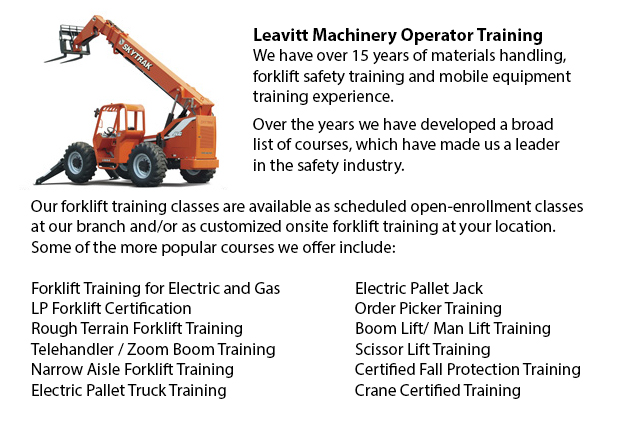
St Catharines Telehandler License - The telehandler or telescopic handler is a generally utilized machine in agricultural and industrial applications. This equipment is the same in look to a forklift and also functions in a similar manner, although telehandlers are much more like a crane than lift truck. It has a telescopic boom which can lengthen upward and forwards from the vehicle. The boom has the capability to fit one of various attachments like muck grab, pallet forks, a bucket or a lift table.
Pallet forks are the most popular accessory designed for the telehandler. This particular machine is normally used for moving loads to and from locations that a conventional forklift will find unreachable. Telehandlers are specially useful for placing loads on rooftops for example, or for removing palletized cargo from with a trailer. A lot of the tasks which a telehandler can accomplish will otherwise need a crane and this machine can be costly, not always time efficient and impractical.
Since the boom raises or extends while bearing a load, it also acts as a lever. Despite the counterweights in the back, this causes the equipment to become increasingly unbalanced; thus, the advantage of the telehandler is actually its greatest limitation. As the working radius increases, the lifting capacity lessens. The working radius is defined as the distance between the center of the load and the front of the wheels.
Like for instance, a telehandler with a 5000 lb capacity with the boom retracted can safely lift as little as 400 lb when it is completely extended at a low boom angle. The equivalent equipment which has a 5000 lb lift capacity and the boom retracted can support up to 10,000 lb with the boom raised to 70 degrees. The operator has a load chart to help determine whether a particular lifting task can be completed in a safe and efficient manner. This particular chart considers the boom angle, the weight and height.
So as to monitor the telehandler, they come equipped with a computer that makes use of sensors. These sensors work to alert the operator, with some being able to cut controls to certain inputs if the limits of the motor vehicle are exceeded. Several telehandler types are also equipped with front outriggers which are referred to as mobile cranes. These greatly extend the lifting capability of the equipment while it is stationary.
-
St Catharines Heavy Equipment Training Schools
St Catharines Heavy Equipment Training Schools - When selecting an operator training course, there are a lot of heavy equipment training schools to choose from. To be able to ascertain the qualifications you will attain, it is very important to explo... More -
St Catharines Heavy Equipment Operator Training
St Catharines Heavy Equipment Operator Training - Heavy equipment operator training facilities that offer quality standards within the business, offering field performance work and additional machine training are really sought after training features... More -
St Catharines Forklift Training Programs
St Catharines Forklift Training Programs - Are you looking for work as a driver of a forklift? Our regulatory-compliant mobile equipment operator training offers instruction in kinds of forklifts, pre-shift check, fuel kinds and handling of fuels, an... More -
St Catharines Heavy Equipment License
St Catharines Heavy Equipment License - A heavy equipment license can be obtained by taking a certification and preparation course at a private training school or a vocational school. This license would qualify you to operate various types of heavy e... More -
St Catharines Overhead Crane Safety Training
St Catharines Overhead Crane Safety Training - Overhead crane safety training equips operators with skills and knowledge regarding crane safety precautions, accident avoidance, materials handling, and equipment and stock protection. Trainees will lea... More -
St Catharines Scissor Lift Training
St Catharines Scissor Lift Training - Scissor lifts should be operated proficiently to be able to protect the safety of the equipment and the wellbeing of others within the workplace. Operators who are skilled are trained to drive the specific type o... More -
St Catharines Telescopic Training
St Catharines Telescopic Training - Telescopic Handlers are a kind of forklift, normally known as telehandlers. This machine has been increasing in popularity due to its greater lift heights and its versatility. It is often preferred over the convent... More -
St Catharines Boom Lift Certification
St Catharines Boom Lift Certification - Utilizing elevated work platforms allow for maintenance operations and work to be carried out at elevated work heights which were otherwise unreachable. Boom Lift Certification Training educates workers about t... More

Forklift Certification St Catharines
TOLL FREE: 1-888-254-6157
St Catharines, Ontario
forkliftcertificationstcatharines.com/
Email Us
About Us


